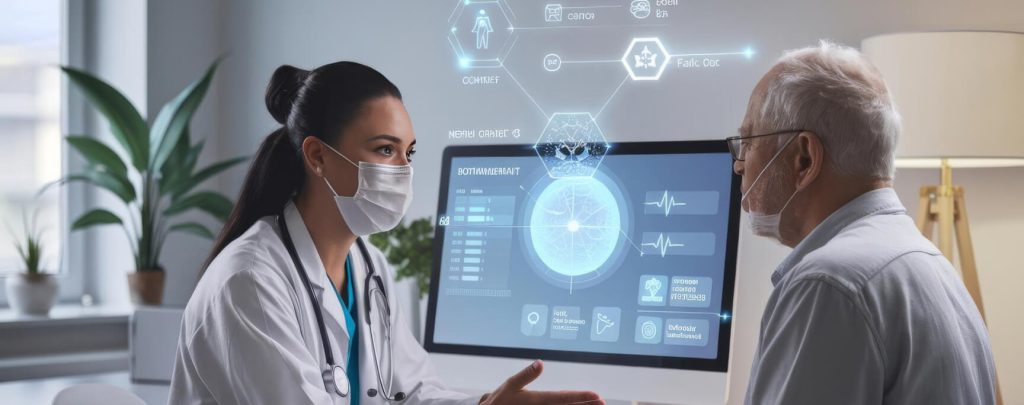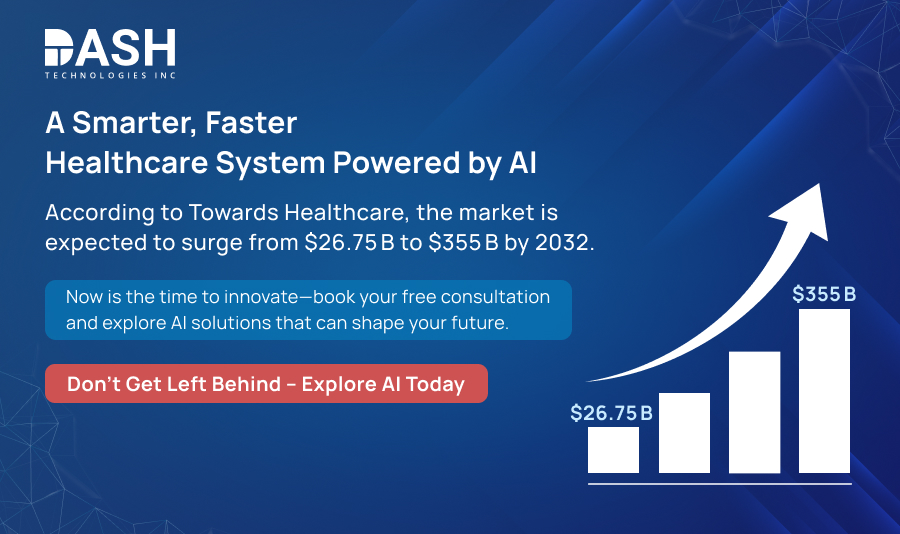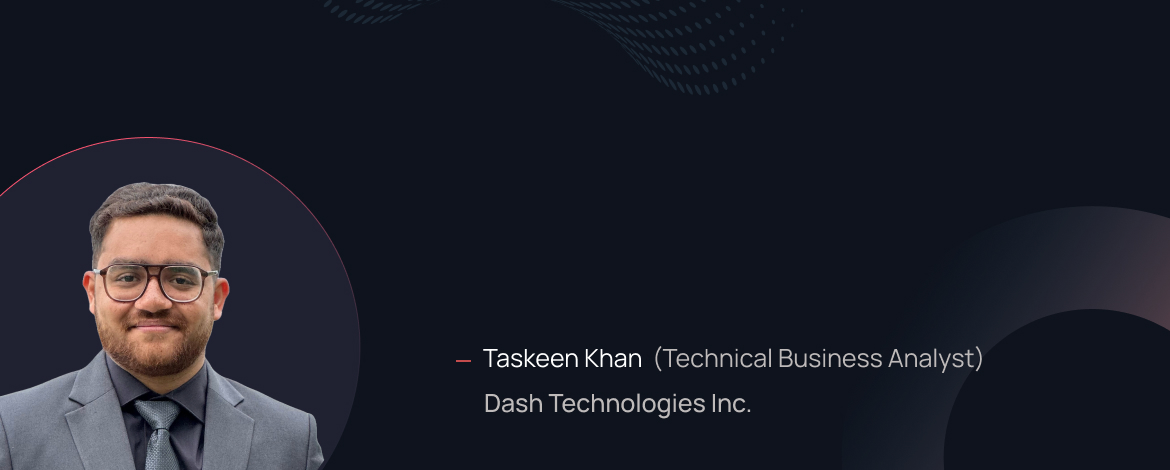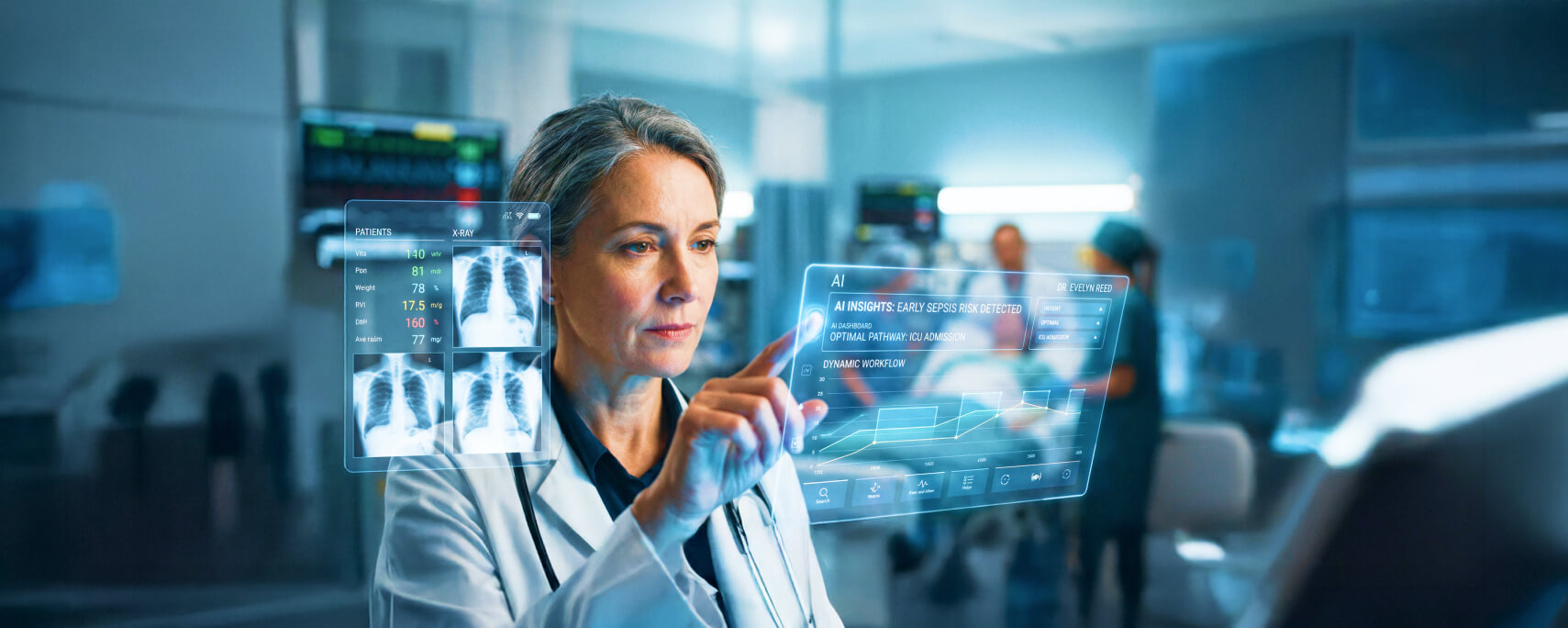Top 5 AI Use Cases in Healthcare for Better Patient Outcomes
For innovation-focused leaders and health system executives, the critical question is no longer whether AI delivers value, but which applications create measurable improvements in patient outcomes. In this blog post, we present five practical, high-impact AI use cases in healthcare that are already delivering on that promise.
Throughout, we emphasize how AI improving patient outcomes is more than a slogan — with the right deployments, outcomes shift measurably (e.g. lower readmissions, fewer diagnostic errors, earlier interventions). Let’s also learn more about healthcare AI benefits that goes beyond hype: safety, personalization, efficiency, and scale.
Top 5 AI Use Cases in Healthcare
1. Medical Imaging & Diagnostics
One major success of applications of AI in healthcare is medical imaging, including radiology and pathology. Deep learning models, such as convolutional neural networks, can analyze CT scans, MRIs, and X-rays. AI in medical diagnosis also examines histopathology slides. These AI-powered healthcare tools detect abnormalities such as tumors, fractures, & lesions quickly and accurately.
- AI can detect suspicious lung nodules or micro-calcifications in mammograms earlier than radiologists.
- It can also prioritize urgent cases. This way, radiologists handle the most critical ones first.
- In pathology, whole-slide image analysis helps quantify biomarkers. It also detects mitoses. This reduces fatigue and errors for pathologists.
These tools help improve patient outcomes by finding diseases early. They also reduce false negatives and positives.
Redefine Diagnostics with Imaging Solutions
Partner with us to engineer imaging solutions that detect earlier, diagnose faster, and set new benchmarks in accuracy.
Let’s Build Together2. Predictive Risk Stratification & Early Intervention
A key AI use in healthcare is predictive modeling. It uses past and real-time data to predict which patients might face complications. This includes risks like sepsis, worsening health, or being readmitted before hitting a critical point.
- Examples of AI in patient care are when AI can predict which hospitalized patients may worsen. It does this by combining lab values, vital signs, demographics, comorbidities, and recent trends. This helps in taking proactive care steps.
- In outpatient settings, risk scores can help identify chronic disease patients who may need hospitalization. This allows for targeted preventive outreach.
- Some models also predict lengths of stay and resource usage, helping with planning.
As these systems spot risks earlier; AI improves patient outcomes and helps clinicians act sooner. They can give preventive care, adjust treatment plans, or increase monitoring. This improves patient outcomes and lowers costs in the long run, a great example of AI improving patient outcomes.
3. Remote Patient Monitoring & Virtual Care (Providers + MedTech)
AI improves patient outcomes in remote patient monitoring (RPM). It uses artificial intelligence and IoT devices to track vitals in real time. This AI healthcare tool helps providers track patients from home. It improves care for those with chronic conditions and after surgery.
Key applications include:
- Chronic disease management: AI-powered healthcare tools monitor wearable-based activity for diabetes, high blood pressure, & cardiovascular disease. The glucose and heart rate trackers provide predictive alerts for early intervention.
- Post-surgical recovery: AI in medical devices monitors heart rate, oxygen levels, & temperature. It helps spot early signs of infection or internal bleeding.
- Elderly and home-based care: AI tools track movement and spot emergencies, offering quick help to at-risk patients.
The success of AI in medical devices for remote care lies in its extraordinary ability to predict and act in real-time. By reducing hospital readmissions, improving medication adherence, and facilitating timely intervention, through remote monitoring, presenting concrete clinical and economic benefits for both patients and healthcare systems due to AI for better patient outcomes.
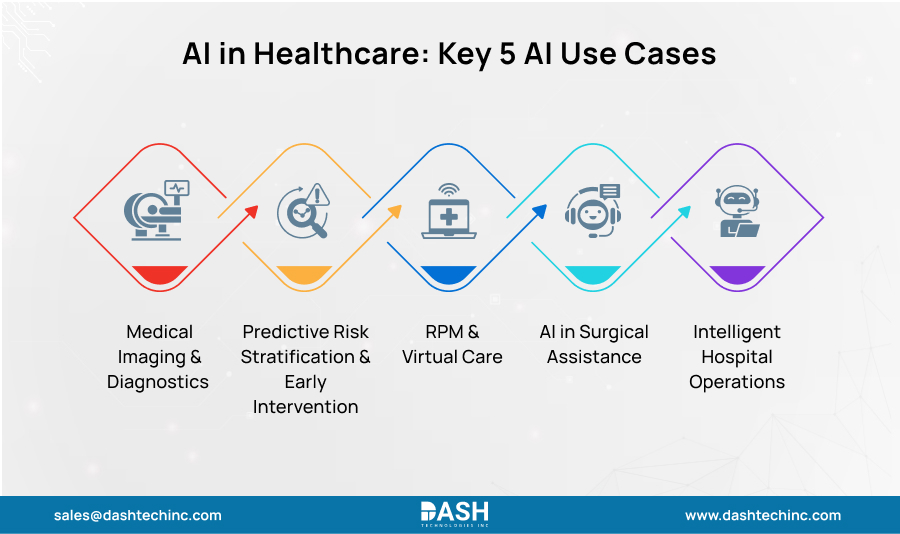
4. AI in Surgical Assistance
AI-powered robotics and real-time guidance are changing surgery. They enhance precision, cut complications, and speed recovery. AI-assisted robotic surgeries can cut operation time by 25% and lower complications by 30% compared to traditional methods. AI applications in healthcare boost surgical precision by 40%. They also reduce recovery time by 15% and lessen post-surgery pain.
AI benefits various surgical specialties:
- General surgery: AI-assisted surgeries demonstrated an average reduction of 30 minutes in surgical time, from 150 to 120 minutes in complex cases involving hepatectomies, colectomies, and cholecystectomies.
- Orthopedic surgery: AI-driven surgical planning and robotic systems offer joint replacements with near-perfect precision using 3D CT-based planning.
- Spinal surgery: AI-guided pedicle screw fixation reduces complication rates from 12.2% to 6.1%. It also shortens surgery times and lowers hospital stays.
Healthcare AI tools like VirtuGuide™ speed up patient analysis. AI use cases in healthcare cut surgical planning time from weeks to days. AI models help with tissue recognition and surgical margin control. They allow surgeons to find safe dissection planes more accurately. Applications of AI in healthcare show how AI enhances patient outcomes. Healthcare AI benefits make surgery safer, faster, & more precise. Human expertise remains central to care.
5. Intelligent Hospital Operations
AI is changing healthcare in many ways. It’s not just helping doctors anymore; it’s also improving operations and administration. AI-driven healthcare solutions make healthcare organizations smarter and leaner. They optimize scheduling, staffing, patient flow, and billing.
For example:
- Scheduling optimization: Predictive AI anticipates patient inflows and staff rosters against demand.
- Bed management: Predictive algorithms forecast patient discharges and admissions, thereby reducing the waiting period.
- Workflow automation: NLP tools summarize notes from EHRs, generate summaries at discharge, and code procedures. This saves time for clinicians in interactions with patients.
These healthcare AI examples illustrate how operations directly affect clinical outcomes. Reduced admin tasks lead to quicker responses, fewer delays, and happier staff. All these factors improve how AI affects patient care.
Hospitals that use intelligent automation see clear gains in efficiency and care coordination. This shows that digital transformation is more than an IT upgrade; it’s a clinical advantage.
Why Outcomes Matter More Than Hype
The healthcare industry is full of promises about Artificial Intelligence. But the most important question is this: Does AI actually deliver improved patient outcomes? The difference between impact and hype shows that real progress is measured by concrete results, not flashy technology.
AI for better patient outcomes already delivers real-world benefits:
- Early detection: Imaging technologies detect cancers, fractures, and strokes earlier, enabling individuals to survive longer.
- Chronic care: Predictive analytics & remote monitoring reduce readmissions by recognizing risk earlier.
- Workflow Efficiency: AI assists by automating your routine tasks, such as paperwork and scheduling. This reduces burnout and improves care delivery.
The difference between hype and impact is clear. It shows how healthcare AI solutions help clinicians and patients directly. Successful organizations prioritize outcomes over technology. They create AI-driven healthcare solutions focused on clinical goals, not just numbers. Sustainable AI in healthcare means tools that blend into workflows. They enhance precision and add lasting value.
Download our infographic: Top 5 AI Use Cases in Healthcare
About Dash

Dash Technologies Inc.
We’re technology experts with a passion for bringing concepts to life. By leveraging a unique, consultative process and an agile development approach, we translate business challenges into technology solutions Get in touch.
